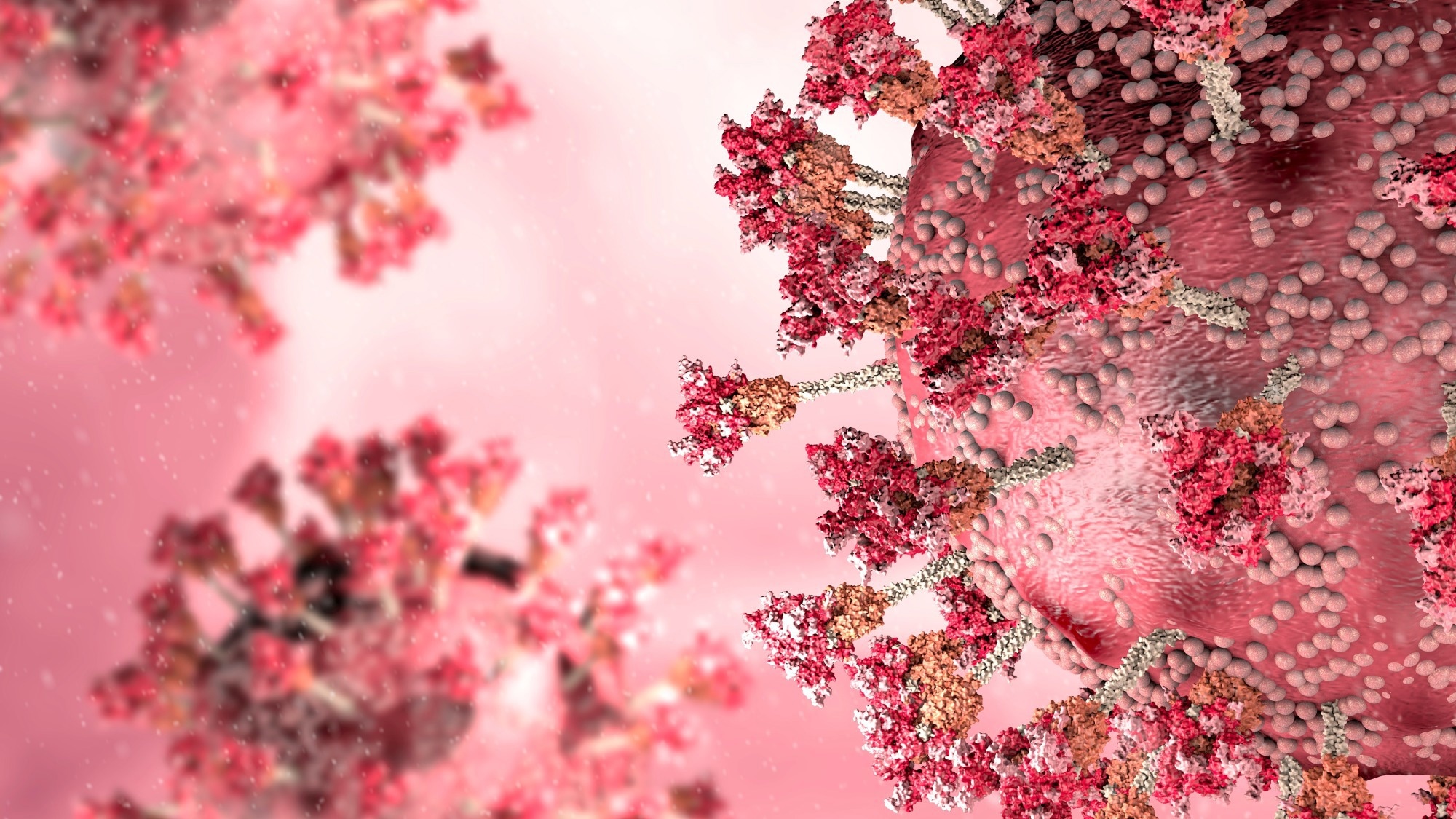 By Neha MathurReviewed by Danielle Ellis, B.Sc.Apr 20 2023
By Neha MathurReviewed by Danielle Ellis, B.Sc.Apr 20 2023In a recent study published in the journal PNAS, researchers demonstrated that the tight junction (TJ) protein occludin (OCLN) is critical for severe acute respiratory syndrome coronavirus 2 (SARS-CoV-2) spike (S)-mediated, direct cell-to-cell transmission inside a host.
 Study: Tight junction protein occludin is an internalization factor for SARS-CoV-2 infection and mediates virus cell-to-cell transmission. Image Credit: Naeblys / Shutterstock
Study: Tight junction protein occludin is an internalization factor for SARS-CoV-2 infection and mediates virus cell-to-cell transmission. Image Credit: Naeblys / Shutterstock
Background
Viral transmission via tight cell-to-cell contact diminishes the effectiveness of antiviral drugs and helps viruses evade neutralizing antibodies (nAbs). Studies have documented that many human viruses, including SARS-CoV-2, influenza A, and respiratory syncytial virus (RSV), use this mechanism, cell-free particles, or both to establish infection and survive inside a host.
Previous studies have also associated the formation of syncytia in human lung tissues with SARS-CoV-2. In SARS-CoV-2 and other coronaviruses (CoVs), e.g., Middle Eastern Respiratory Syndrome (MERS-CoV), syncytia formation contributes to the augmented direct cell-to-cell transmission. However, the host factors involved in this process and the underlying mechanisms of S glycoprotein–induced cell-to-cell dissemination of SARS-CoV-2 remain unclear.
Epithelial cells in human airways have intercellular structures called TJs that regulate the passage of ions and small solutes. They also serve as the first barrier to pathogens. TJs contain the protein OCLN, acknowledged as a vital host factor for the entry of several viruses inside a human host, e.g., rotavirus, and hepatitis C virus.
Since the virus-induced fusion of virus-infected cells with neighboring cells and the creation of syncytia requires breaking the intercellular barrier, the researchers speculated that TJ proteins might be involved in the spread of SARS-CoV-2 via cell-to-cell transmission.
About the study
In the present study, researchers examined the effect of SARS-CoV-2 infection on TJ proteins, which helped them uncover a previously unknown role of OCLN as a host-origin internalization factor for SARS-CoV-2 entry and subsequent cell-to-cell transmission within the host cells. They used Vero-E6 cells infected with replication-competent vesicular stomatitis virus (rVSV) expressing enhanced green fluorescent protein (eGFP) and SARS-CoV-2 S (rVSV-eGFP-S), and alternatively, a SARS-CoV-2 recombinant expressing the mNeonGreen gene to determine the distribution of OCLN in infected Vero-E6 cells.
Western blot confirmed that infections by both recombinants altered OCLN expression. Accordingly, OCLN levels became undetectable 48 hour postinfection (pi) in infected Vero-E6 cells. The team also confirmed these results in human-derived A549-hACE2 cells and a hamster SARS-CoV-2 infection model.
Next, the team determined whether permissive cells, e.g., Vero-E6 and A549-hACE2 cells, also need OCLN for the establishment of SARS-CoV-2 infection. So, they transfected Vero-E6 cells with two OCLN-targeted small interfering RNAs (siRNAs), which helped them confirm OCLN expression using the immunofluorescence assay (IFA) and quantitative reverse transcriptase-polymerase chain reaction (RT-qPCR). Furthermore, the researchers performed the coimmunoprecipitation (co-IP) assay to visualize the OCLN's interaction with the SARS-CoV-2 S protein.
OCLN is a transmembrane protein with four-helical domains, viz., an intracellular N-terminal domain, a long cytoplasmic tail, also known as C-terminal, two extracellular loops, EL1 & EL2 linked via a short intracellular loop. So, finally, the researchers determined which OCLN domain was critical for SARS-CoV-2 internalization and cell-to-cell transmission.
To this end, the team constructed four OCLN deletion constructs, viz., hOCLN/ΔC, hOCLN/ΔE1, hOCLN/ΔE2, and hOCLN/ΔN, and transfected them into the OCLN KO Vero-E6 cell line. Next, they confirmed the expression of each using Western blot and IFA.
Results
The study pointed out that OCLN, a host factor, mediated SARS-CoV-2 internalization and subsequent cell-to-cell transmission. Thus, its knockdown decreased SARS-CoV-2 spread, while its overexpression promoted it in experiments with rVSVs expressing S proteins of multiple SARS-CoV-2 variants. In vitro and in vivo SARS-CoV-2 infection markedly decreased and eventually completely destructed OCLN.
All rVSVs expressing S proteins of the SARS-CoV-2 Delta, Beta, and Kappa variants exhibited enhanced cell-to-cell transmission than the WA-1 strain. The Gamma & Alpha variants exhibited comparable abilities to drive syncytium formation as the WA-1 strain. Intriguingly, Omicron exhibited a markedly decimated capacity to form syncytia in A549-hACE2 cells relative to other SARS-CoV-2 variants and WA-1, indicating that Omicron has limited ability to spread cell-cell using the endocytic pathway. This observation also justifies why Omicron BA.1/BA.2 sublineages trigger trivial clinical symptoms than WA-1 and other SARS-CoV-2 variants.
Further, the study experiments suggested that SARS-CoV-2 infection only degraded OCLN but had minimal impact on other TJ proteins, e.g., Claudin-1. Future studies should investigate the mechanisms underlying the mechanisms of SARS-CoV-2-induced down-regulation of the synthesis and stability of the OCLN protein in TJs. In SARS-CoV-2 permissive cells, the knockdown of OCLN did not impact angiotensin-converting enzyme 2 (ACE2) expression but markedly reduced viral infection, especially during the internalization step and subsequent viral replication. Conversely, its overexpression significantly enhanced both SARS-CoV-2's internalization and replication but not its binding. Thus, OCLN could not be considered a receptor or coreceptor for SARS-CoV-2 entry.
The study results also revealed that the endosomal entry pathway was engaged in OCLN-mediated SARS-CoV-2 cell-to-cell transmission. Finally, treatment with trypsin markedly promoted SARS-CoV-2 cell-to-cell transmission and augmented virus yield in host cells, suggesting that this phenomenon helps preserve viral infectivity and transmissibility more than cell-free transmission.
Conclusions
The current study provided mechanistic insights into SARS-CoV-2 entry and subsequent spread inside a human host. The researchers presented robust substantiation of OCLN-driven cell-to-cell transmission of WA-1, and all other SARS-CoV-2 variants examined in this study. Indeed, OCLN is a crucial host factor involved in SARS-CoV-2 internalization and subsequent cell-to-cell viral transmission.
Journal reference:
- Tight junction protein occludin is an internalization factor for SARS-CoV-2 infection and mediates virus cell-to-cell transmission, Jialin Zhang, Wenyu Yang, Sawrab Roy, Heidi Liu, R. Michael Roberts, Liping Wang, Lei Shi, Wenjun Ma, PNAS 2023, DOI: https://doi.org/10.1073/pnas.2218623120, https://www.pnas.org/doi/10.1073/pnas.2218623120